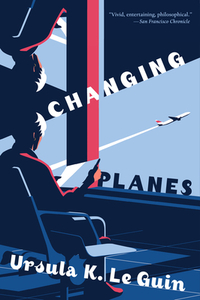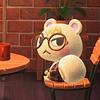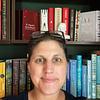Take a photo of a barcode or cover
I had thought I was buying a novel about Sita Dulip's adventures in airport liminal spaces. Well, turns out, it’s not a novel, and it’s not about Sita Dulip's adventures either -- it’s a series of travel vignettes about odd societies visited by a friend of Sita’s, and records she collected from other travellers. There is some fabulous burns about airports and their universally accommodating ways, but that’s barely a few pages out of the whole book, though they are some AH YES SWEET VINDICATION levels of good.
They are anthropological curiosities, seen and described by interplanar travellers who are close to us and therefore likely to touch what would any of us be likely to dwell on: the differences and similarities to our own culture and history. And here I really came to appreciate that the narrator is never rubbing any conclusions in your face. You are only offered a view onto something new -- окно в Европу, if you will -- that both stands scrutiny it its own sight, a land unseen, and of course serves as a curiously angled looking glass aimed the world we know. No wonder why some reviewers likened it to Gulliver’s travels: while never a fan of the book (his travels got too brickalicious and too wild too soon, imo), I see where the simile comes from. In fact, Changing Planes directly references Gulliver at one point.
They are not MINDBLOWING AND EXCITING kind of depictions of fancy foreign lands; instead, they are quiet and thoughtful descriptions that easily lead you to the same state of mind. The point was never to play Sheherazade, and captivating the reader with colorful imagery never more important that triggering a little introspection. The levels of subtleness of caricatures and just how striking the metaphors are may vary, but I felt all stories were worth exploring. Ones that would probably stay in my memory are these:
---Sita Dulip’s Method --- that’s where the most of delicious bitching about airport limbo comes from
---Porridge on Islac --- the chilling “four percent maize” aside (which, wow, did I find it chilling, both for the implication and for the idiot governance around it), I guess it’s the connection with strangers over understated stories of woe that resonated with me, associating heavily with my work in the post-Soviet space.
---Seasons of Ansarac --- I get the social metaphor, but real talk: I just completely dig this avian society, and the way Ursula likes to play with implications of how a change in sex & associated rules can have a huge impact on productivity and conflicts in a given society (that’s the stuff like LHOD minus Genly Ai!! *fistbump*)
---Social Dreaming of the Frin --- DELIGHTFULLY CREEPY, an observation of how communities can take to shared dreaming, when there is no personal boundaries keeping the mundane, the creepy, the erotic and the disturbed to the confines of YOUR brain alone. Thinking about how this could affect children exposed to the unsavoury contents of adults’s brain in long term made me shiver so much.
---The Royals of Hegn --- one of the more caricature observations, but so scathingly funny. I suspect the British would relate the most to it, but the ridiculousness of tabloid obsessed with celebrity publicity is universal enough for everyone to enjoy.
---Nna Moy Language --- I started liking for the linguistic geekery that the story opens with, dwelling on inaccessibility of a language that infinitely relies on context to define meaning of any word, but I was struck by ending, too, which turned more defiant and sad than I had expected.
---Fliers of Gy --- the second avian-themed story in the book, and also interesting to me, less because of the imagery and more because I kept wondering where this was going and changing my mind halfway through from one extreme to the other. I’m still not sure, to be quite honest, but the ending note clinched it as something I would remember.
Would definitely recommend reading this while catching a plane (as I gleefully did)
They are anthropological curiosities, seen and described by interplanar travellers who are close to us and therefore likely to touch what would any of us be likely to dwell on: the differences and similarities to our own culture and history. And here I really came to appreciate that the narrator is never rubbing any conclusions in your face. You are only offered a view onto something new -- окно в Европу, if you will -- that both stands scrutiny it its own sight, a land unseen, and of course serves as a curiously angled looking glass aimed the world we know. No wonder why some reviewers likened it to Gulliver’s travels: while never a fan of the book (his travels got too brickalicious and too wild too soon, imo), I see where the simile comes from. In fact, Changing Planes directly references Gulliver at one point.
They are not MINDBLOWING AND EXCITING kind of depictions of fancy foreign lands; instead, they are quiet and thoughtful descriptions that easily lead you to the same state of mind. The point was never to play Sheherazade, and captivating the reader with colorful imagery never more important that triggering a little introspection. The levels of subtleness of caricatures and just how striking the metaphors are may vary, but I felt all stories were worth exploring. Ones that would probably stay in my memory are these:
---Sita Dulip’s Method --- that’s where the most of delicious bitching about airport limbo comes from
---Porridge on Islac --- the chilling “four percent maize” aside (which, wow, did I find it chilling, both for the implication and for the idiot governance around it), I guess it’s the connection with strangers over understated stories of woe that resonated with me, associating heavily with my work in the post-Soviet space.
---Seasons of Ansarac --- I get the social metaphor, but real talk: I just completely dig this avian society, and the way Ursula likes to play with implications of how a change in sex & associated rules can have a huge impact on productivity and conflicts in a given society (that’s the stuff like LHOD minus Genly Ai!! *fistbump*)
---Social Dreaming of the Frin --- DELIGHTFULLY CREEPY, an observation of how communities can take to shared dreaming, when there is no personal boundaries keeping the mundane, the creepy, the erotic and the disturbed to the confines of YOUR brain alone. Thinking about how this could affect children exposed to the unsavoury contents of adults’s brain in long term made me shiver so much.
---The Royals of Hegn --- one of the more caricature observations, but so scathingly funny. I suspect the British would relate the most to it, but the ridiculousness of tabloid obsessed with celebrity publicity is universal enough for everyone to enjoy.
---Nna Moy Language --- I started liking for the linguistic geekery that the story opens with, dwelling on inaccessibility of a language that infinitely relies on context to define meaning of any word, but I was struck by ending, too, which turned more defiant and sad than I had expected.
---Fliers of Gy --- the second avian-themed story in the book, and also interesting to me, less because of the imagery and more because I kept wondering where this was going and changing my mind halfway through from one extreme to the other. I’m still not sure, to be quite honest, but the ending note clinched it as something I would remember.
Would definitely recommend reading this while catching a plane (as I gleefully did)
One to read while travelling — flashes of insight, gentler explorations, germs of worlds that passed too fast to settle into them
I am a big fan of le Guin, but this is definitely not a favourite collection. It's amusing, but it's not excellent (for me, anyway).
The conceit behind the collection I did really like: the idea that the boredom of sitting in an airport could trigger a visit to - wait for it - a different plane, as in of existence. It seems to be that the body itself does the travelling, because people come back with presents and sometimes arrive back on their own plane upside down. This is quite a fun take on the idea of alternate realities, since I think the idea also is that all of these planes are variations on Earth.
Each story in this collection is set in, or describes, a different plane, and many of them have little actual plot. It's more like a travelogue, which makes sense and perhaps accounts for my less-than-in-love reaction. Some of them are very clever; some of them are quite clearly making a specific point about contemporary ideas, technology, or issues, or are presenting a topsy-turvy view to challenge and confront the reader. So there's a plane where almost everyone is royalty; one where after about the age of 7, hardly anyone speaks; and one where people share their neighbours' dreams. There's a plane where two major cities fought for decades over a couple of acres of riverside property, and one where developing wings is a disability to be pitied. On another plane a scientific experiment attempted to develop children with no need of sleep, raising questions of the necessity of consciousness and sleep for sentience, and another where violence is a way of life.
I guess I expect le Guin to always turn out serious, hard-hitting and difficult fiction, which this is - largely - not. It's a bit unreasonable of me, but there you go; I don't expect light-hearted from her! It is a delightful collection, though, and of course all of the stories are very well written and there are some totally delightful descriptions.
The conceit behind the collection I did really like: the idea that the boredom of sitting in an airport could trigger a visit to - wait for it - a different plane, as in of existence. It seems to be that the body itself does the travelling, because people come back with presents and sometimes arrive back on their own plane upside down. This is quite a fun take on the idea of alternate realities, since I think the idea also is that all of these planes are variations on Earth.
Each story in this collection is set in, or describes, a different plane, and many of them have little actual plot. It's more like a travelogue, which makes sense and perhaps accounts for my less-than-in-love reaction. Some of them are very clever; some of them are quite clearly making a specific point about contemporary ideas, technology, or issues, or are presenting a topsy-turvy view to challenge and confront the reader. So there's a plane where almost everyone is royalty; one where after about the age of 7, hardly anyone speaks; and one where people share their neighbours' dreams. There's a plane where two major cities fought for decades over a couple of acres of riverside property, and one where developing wings is a disability to be pitied. On another plane a scientific experiment attempted to develop children with no need of sleep, raising questions of the necessity of consciousness and sleep for sentience, and another where violence is a way of life.
I guess I expect le Guin to always turn out serious, hard-hitting and difficult fiction, which this is - largely - not. It's a bit unreasonable of me, but there you go; I don't expect light-hearted from her! It is a delightful collection, though, and of course all of the stories are very well written and there are some totally delightful descriptions.
adventurous
reflective
relaxing
medium-paced
Plot or Character Driven:
Plot
Strong character development:
Complicated
Flaws of characters a main focus:
Complicated
I love U. K. L., but this book felt to me like a writing exercise. I liked the concept of the book more than the experience of reading it. After several stories that left me cold, I decided to shelve it (but with a deep respect for the author.)
An anthropological study of other "planes" or dimensions. Fascinating study, but reads like a text book at times. Well crafted ideas told matter of fairly.
What an awesome book that was! And what a wonderful introduction to Ursula K. Le Guin.
Changing Planes is a book about astral travel in which the author explores what society and life would be like on different planes. She talks about immortality, sex, food, genes, death, and many other things, and does so in a way that is both quirky and fascinating.
Some of the planes were a little boring, but they were few and far between. Most of the planes she discussed just made me wish I could go there and experience them for myself. She also got me thinkng about what these planes would look like if they were adapted into a film or a TV show. There's some food for thought!
Changing Planes is a book about astral travel in which the author explores what society and life would be like on different planes. She talks about immortality, sex, food, genes, death, and many other things, and does so in a way that is both quirky and fascinating.
Some of the planes were a little boring, but they were few and far between. Most of the planes she discussed just made me wish I could go there and experience them for myself. She also got me thinkng about what these planes would look like if they were adapted into a film or a TV show. There's some food for thought!
adventurous
funny
hopeful
inspiring
lighthearted
fast-paced
Plot or Character Driven:
Plot
Strong character development:
No
Loveable characters:
Yes
Diverse cast of characters:
Yes
Flaws of characters a main focus:
No
medium-paced
3/5 stars - more vignettes than story, but interesting imagining different species and different planets
Quite possibly the most imaginative thing I’ve ever read







